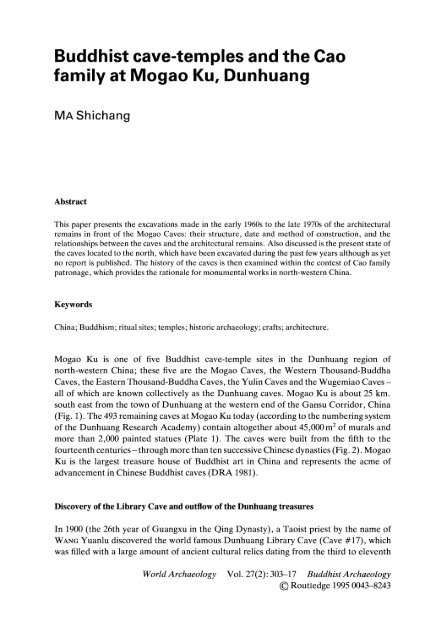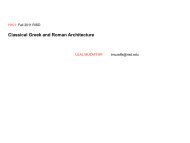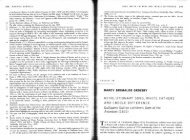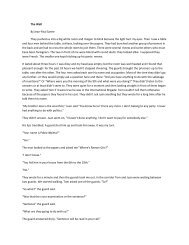Buddhist Cave-Temples and the Cao Family at Mogao Ku ...
Buddhist Cave-Temples and the Cao Family at Mogao Ku ...
Buddhist Cave-Temples and the Cao Family at Mogao Ku ...
Create successful ePaper yourself
Turn your PDF publications into a flip-book with our unique Google optimized e-Paper software.
<strong>Buddhist</strong> cave-temples <strong>and</strong> <strong>the</strong> <strong>Cao</strong><br />
family <strong>at</strong> <strong>Mogao</strong> <strong>Ku</strong>, Dunhuang<br />
MA Shichang<br />
Abstract<br />
This paper presents <strong>the</strong> excav<strong>at</strong>ions made in <strong>the</strong> early 1960s to <strong>the</strong> l<strong>at</strong>e 1970s of <strong>the</strong> architectural<br />
remains in front of <strong>the</strong> <strong>Mogao</strong> <strong>Cave</strong>s: <strong>the</strong>ir structure, d<strong>at</strong>e <strong>and</strong> method of construction, <strong>and</strong> <strong>the</strong><br />
rel<strong>at</strong>ionships between <strong>the</strong> caves <strong>and</strong> <strong>the</strong> architectural remains. Also discussed is <strong>the</strong> present st<strong>at</strong>e of<br />
<strong>the</strong> caves loc<strong>at</strong>ed to <strong>the</strong> north, which have been excav<strong>at</strong>ed during <strong>the</strong> past few years although as yet<br />
no report is published. The history of <strong>the</strong> caves is <strong>the</strong>n examined within <strong>the</strong> contest of <strong>Cao</strong> family<br />
p<strong>at</strong>ronage, which provides <strong>the</strong> r<strong>at</strong>ionale for monumental works in north-western China.<br />
Keywords<br />
China; Buddhism; ritual sites; temples; historic archaeology; crafts; architecture.<br />
<strong>Mogao</strong> <strong>Ku</strong> is one of five <strong>Buddhist</strong> cave-temple sites in <strong>the</strong> Dunhuang region of<br />
north-western China; <strong>the</strong>se five are <strong>the</strong> <strong>Mogao</strong> <strong>Cave</strong>s, <strong>the</strong> Western Thous<strong>and</strong>-Buddha<br />
<strong>Cave</strong>s, <strong>the</strong> Eastern Thous<strong>and</strong>-Buddha <strong>Cave</strong>s, <strong>the</strong> Yulin <strong>Cave</strong>s <strong>and</strong> <strong>the</strong> Wugemiao <strong>Cave</strong>s -<br />
all of which are known collectively as <strong>the</strong> Dunhuang caves. <strong>Mogao</strong> <strong>Ku</strong> is about 25 km.<br />
south east from <strong>the</strong> town of Dunhuang <strong>at</strong> <strong>the</strong> western end of <strong>the</strong> Gansu Corridor, China<br />
(Fig. 1). The 493 remaining caves <strong>at</strong> <strong>Mogao</strong> <strong>Ku</strong> today (according to <strong>the</strong> numbering system<br />
of <strong>the</strong> Dunhuang Research Academy) contain altoge<strong>the</strong>r about 45,000m2 of murals <strong>and</strong><br />
more than 2,000 painted st<strong>at</strong>ues (Pl<strong>at</strong>e 1). The caves were built from <strong>the</strong> fifth to <strong>the</strong><br />
fourteenth centuries - through more than ten successive Chinese dynasties (Fig. 2). <strong>Mogao</strong><br />
<strong>Ku</strong> is <strong>the</strong> largest treasure house of <strong>Buddhist</strong> art in China <strong>and</strong> represents <strong>the</strong> acme of<br />
advancement in Chinese <strong>Buddhist</strong> caves (DRA 1981).<br />
Discovery of <strong>the</strong> Library <strong>Cave</strong> <strong>and</strong> outflow of <strong>the</strong> Dunhuang treasures<br />
In 1900 (<strong>the</strong> 26th year of Guangxu in <strong>the</strong> Qing Dynasty), a Taoist priest by <strong>the</strong> name of<br />
WANG Yuanlu discovered <strong>the</strong> world famous Dunhuang Library <strong>Cave</strong> (<strong>Cave</strong> #17), which<br />
was filled with a large amount of ancient cultural relics d<strong>at</strong>ing from <strong>the</strong> third to eleventh<br />
World Archaeology Vol. 27(2): 303-17 <strong>Buddhist</strong> Archaeology<br />
? Routledge 1995 0043-8243





